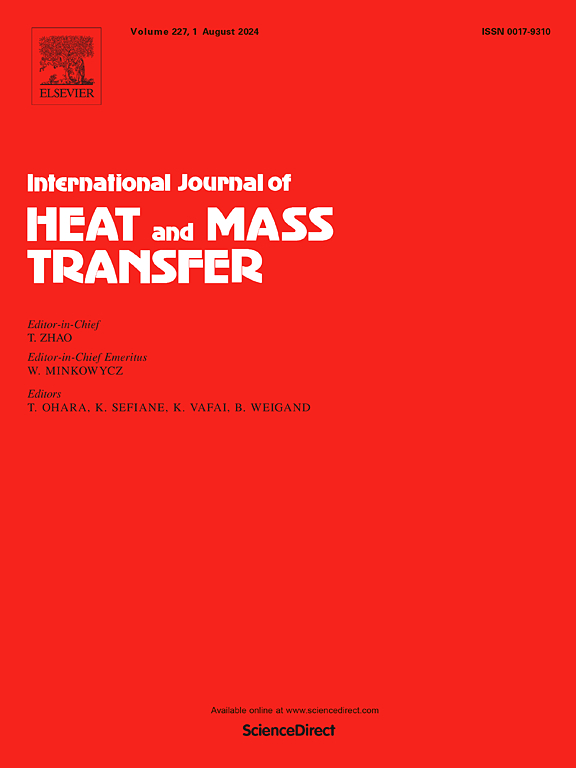Modelling of wave velocity, wave frequency and interfacial friction factor in vertical upward and downward annular flow
IF 5
2区 工程技术
Q1 ENGINEERING, MECHANICAL
International Journal of Heat and Mass Transfer
Pub Date : 2025-04-26
DOI:10.1016/j.ijheatmasstransfer.2025.127157
引用次数: 0
Abstract
Accurate closure laws for roll wave velocity, roll wave frequency and interfacial friction factor are crucial for eddy diffusivity modelling of heat transfer coefficient and liquid film thickness in annular flow boiling. The focus of this work is to develop suitable models for these parameters from flow boiling data by the authors and adiabatic two-phase flow data in open literature. The flow boiling data were obtained from a test loop consisting of a vertical 6mmID transparent heated test section and the test fluid was HFE-7000 refrigerant. The flow boiling data for mean roll wave velocity, mean roll wave frequency and interfacial friction factor were functions of the mass flux, vapor quality, wall heat flux and flow orientation relative to gravity. Models for predicting the roll wave parameters and interfacial friction factor in annular two-phase flow were developed and these models were validated using flow boiling data from this work and adiabatic data from open literature with the mean absolute percentage error (MAPE) serving as the figure of merit. The proposed model for the roll wave velocity of upward and downward flow boiling predicted the measured data within ±15 % with MAPE of 5.0 % and 2.2 % respectively. In the case of roll wave frequency, the proposed model for upward and downward flow boiling predicted the measured data within ±20 % with MAPE of 7.02 % and 5.87 % respectively. These correlations also reproduced the mass flux, vapor quality and wall heat flux dependence of these wave parameters in both flow orientations relative to gravity. The proposed models for the wave velocity and wave frequency predicted literature data for adiabatic gas-liquid flows within ±30 % with maximum MAPE of 16.4 % and 35.2 % respectively. The predicted roll wave velocity and roll wave frequency were also used to predict the measured flow boiling interfacial friction factor. The predicted interfacial friction factor was within ±30 % of the measured data with MAPE of 10.8 % and 20.3 % for upward and downward flow respectively.
垂直上下环空流动中波速、波频和界面摩擦系数的模拟
准确的滚转波速度、滚转波频率和界面摩擦系数的闭合规律对环形流沸腾传热系数和液膜厚度的涡流扩散率建模至关重要。本工作的重点是根据作者的流动沸腾数据和公开文献中的绝热两相流数据建立适合这些参数的模型。流动沸腾数据由垂直6mmID透明加热试验段组成的试验回路获得,试验流体为HFE-7000制冷剂。平均横摇波速度、平均横摇波频率和界面摩擦系数是质量通量、蒸汽质量、壁面热流密度和相对于重力的流动方向的函数。建立了预测环空两相流中横摇波参数和界面摩擦系数的模型,并利用本文的流动沸腾数据和公开文献中的绝热数据,以平均绝对百分比误差(MAPE)作为优点值,对这些模型进行了验证。所建立的上、下流沸腾滚波速度模型对实测数据的预测精度在±15%以内,MAPE分别为5.0%和2.2%。在横摇波频率下,所建立的上下流沸腾模型对实测数据的预测精度在±20%以内,MAPE分别为7.02%和5.87%。这些相关性还再现了这些波参数在两种流动方向上相对于重力的质量通量、蒸汽质量和壁面热流密度的依赖关系。所建立的波速和波频模型预测了±30%范围内的绝热气液流动的文献数据,最大MAPE分别为16.4%和35.2%。用预测的横摇波速度和横摇波频率来预测实测流沸腾界面摩擦系数。预测的界面摩擦系数与实测数据的误差在±30%以内,向上和向下流动的MAPE分别为10.8%和20.3%。
本文章由计算机程序翻译,如有差异,请以英文原文为准。
求助全文
约1分钟内获得全文
求助全文
来源期刊
CiteScore
10.30
自引率
13.50%
发文量
1319
审稿时长
41 days
期刊介绍:
International Journal of Heat and Mass Transfer is the vehicle for the exchange of basic ideas in heat and mass transfer between research workers and engineers throughout the world. It focuses on both analytical and experimental research, with an emphasis on contributions which increase the basic understanding of transfer processes and their application to engineering problems.
Topics include:
-New methods of measuring and/or correlating transport-property data
-Energy engineering
-Environmental applications of heat and/or mass transfer

 求助内容:
求助内容: 应助结果提醒方式:
应助结果提醒方式:


